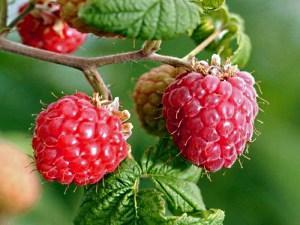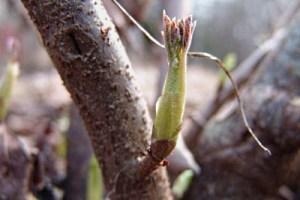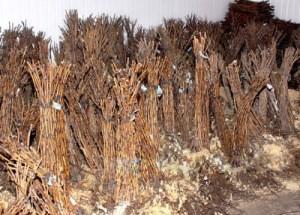The main methods of breeding raspberries
 How raspberries multiply, knows almost any experienced gardener, which cannot be said about novice gardeners. For them, this article will become a real find, and experienced amateurs will also learn something new for themselves.
How raspberries multiply, knows almost any experienced gardener, which cannot be said about novice gardeners. For them, this article will become a real find, and experienced amateurs will also learn something new for themselves.
Today, there are several ways to breed raspberries. Here are the most common ones:
- Green as well as root cuttings;
- Root offspring;
- Seeds.
Reproduction of raspberries by cuttings
This method is most common among gardeners. It doesn't take long and is fairly easy to learn. Raspberries can be propagated by green as well as by root cuttings. The methods are slightly different from each other, so let's give a description of each of them.
- Propagation of raspberries using green cuttings. The essence of the method lies in the fact that the reproduction of raspberries occurs when using the root suckers of the bush. It is noteworthy that they appear (usually in the aisles) after several years of planting existence. Such sprouts do not have a root system, therefore they are used not as seedlings, but as cuttings, which can later give roots.

After the time has elapsed, the cuttings can be planted under the film. To make them well accepted, you need to monitor the humidity (it should be high), under the so-called shelter, and the temperature regime (22-25 degrees).
IMPORTANT! This method is used when green cuttings already have 2 or 3 true leaves. If you do this operation earlier, there is a high probability that the young raspberry will not take root.
- Reproduction of raspberries using root cuttings. This method is less popular as it has some disadvantages. In particular, when digging up the roots (this is a prerequisite for reproduction by this method), the raspberry bush itself is often damaged. After that, he is ill for a long time, and in some cases may die. Despite this, this method has a right to exist, and therefore we will talk about it in more detail.
Digging up the roots is carried out mainly in the aisles, this allows you to minimize damage to nearby growing bushes. The roots (or root cuttings) are selected the strongest, their length should vary between 10-15 cm.The best specimens (those with lateral branches) are laid out in small grooves (5 mm deep), covered with earth and, as they dry the soil is watered. After a while, new raspberry bushes will break through to the surface.
Reproduction of raspberries by root suckers
 This method is the most versatile and widely used among experienced gardeners. Root offspring is a more mature green stalk that has its own root system, but depends on the mother bush. In the fall, they are dug up and transferred to a new place. So that the future shrub got accustomed well, it must be systematically watered and at first do not allow the sun's rays to fall on the leaves of the plant. To do this, you can pull a rag over the root suckers.
This method is the most versatile and widely used among experienced gardeners. Root offspring is a more mature green stalk that has its own root system, but depends on the mother bush. In the fall, they are dug up and transferred to a new place. So that the future shrub got accustomed well, it must be systematically watered and at first do not allow the sun's rays to fall on the leaves of the plant. To do this, you can pull a rag over the root suckers.
Propagation of raspberries by seeds
This method is practically not common among gardeners, since it requires a lot of labor and a lot of time. This method is usually used by breeders.
Raspberries are taken and pounded through a strainer. The seeds, along with the pulp, are placed in a glass of water and washed thoroughly. The floating seeds are not suitable for planting, it is believed that they are still underdeveloped and will not be able to give offspring. The remaining specimens are thoroughly dried. After the done action, they can be immediately sown into boxes, however, experts recommend not to rush with this.
For better seed germination, special treatment is needed. In particular, the seed is placed in water for a day. After a while, the liquid is drained and the seeds are mixed with wet river sand. The prepared consistency is laid out in nylon bags (if there are none at hand, then you can use ordinary tights) and placed in a container suitable for this (ordinary boxes can play its role). Then the bags of seeds are covered with wet moss or pre-steamed sawdust. All this must be removed, preferably in a cool place, for example, underground or, if space permits, in the refrigerator.
The containers with all the contents must stand for three months, then the seeds, along with the sand, are removed and sown into the boxes.
IMPORTANT! For raspberry seeds to sprout faster, you need to sow them in grooves, the depth of which should be about 5 mm. Sprinkle the seedlings on top with a layer of peat or sand. After that, the box must be covered with glass or polyethylene and put in a bright place where the direct rays of the sun will not penetrate.
 When all of the above actions are done, you need to be patient and wait. Let's say right away that not all seeds will germinate. Successful outcome - 50%. The seedlings are ready for diving (transplanting into separate plastic cups) when their height is 10 cm. Future seedlings are kept in containers until relatively warm weather comes outside. When this happens, the seedlings must be planted in open ground. It is advisable to find a sunny location protected from the winds. After 2 years, full-fledged seedlings will grow from the seedlings.
When all of the above actions are done, you need to be patient and wait. Let's say right away that not all seeds will germinate. Successful outcome - 50%. The seedlings are ready for diving (transplanting into separate plastic cups) when their height is 10 cm. Future seedlings are kept in containers until relatively warm weather comes outside. When this happens, the seedlings must be planted in open ground. It is advisable to find a sunny location protected from the winds. After 2 years, full-fledged seedlings will grow from the seedlings.
Attention! Even if you choose to use this method, remember that varietal qualities are not preserved.
In fact, today there are a couple of three more ways to propagate raspberries, for example, with tops. However, these methods are not widely used. Cuttings remain an ideal option for many gardeners.